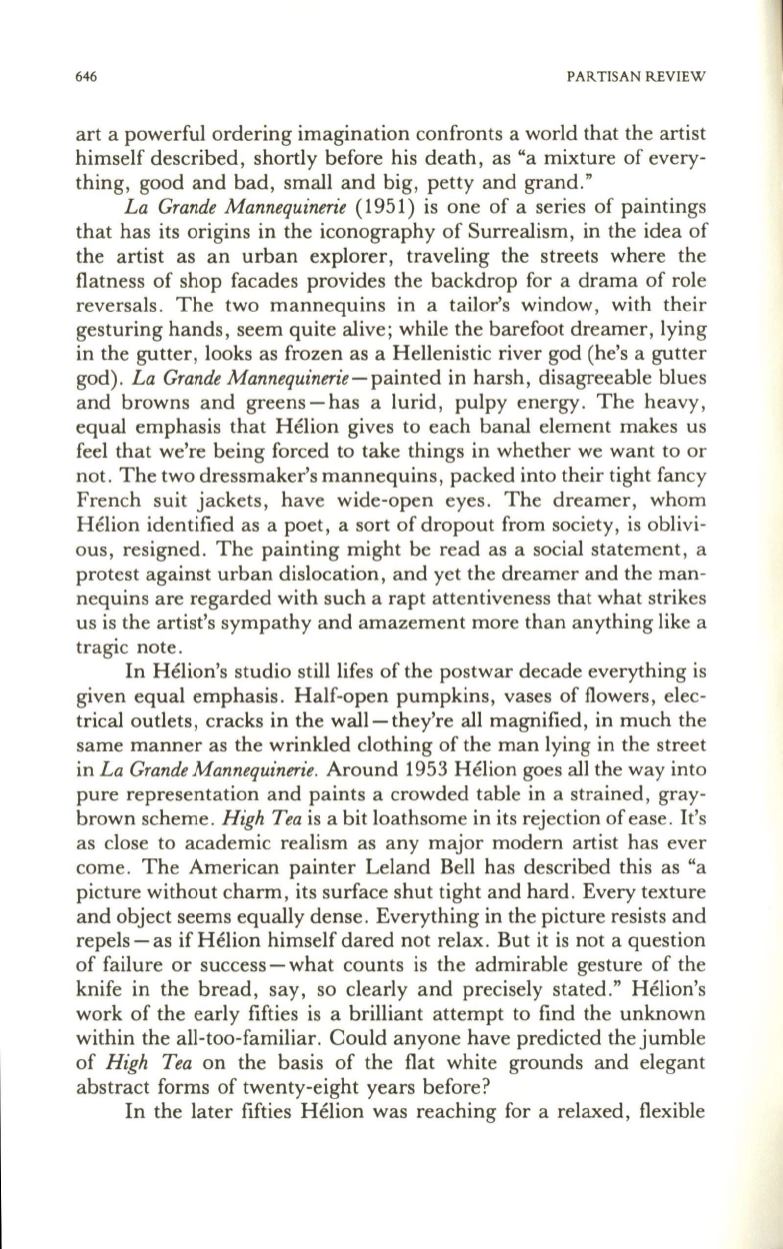
646
PARTISAN REVIEW
art a powerful ordering imagination confronts a world that the artist
himself described, shortly before his death, as "a mixture of every–
thing, good and bad, small and big, petty and grand."
La Grande Mannequinerie
(1951) is one of a series of paintings
that has its origins in the iconography of Surrealism, in the idea of
the artist as an urban explorer, traveling the streets where the
flatness of shop facades provides the backdrop for a drama of role
reversals . The two mannequins in a tailor's window, with their
gesturing hands, seem quite alive; while the barefoot dreamer, lying
in the gutter, looks as frozen as a Hellenistic river god (he's a gutter
god).
La Grande Mannequinerie-painted
in harsh, disagreeable blues
and browns and greens - has a lurid, pulpy energy. The heavy,
equal emphasis that Helion gives to each banal element makes us
feel that we're being forced to take things in whether we want to or
not. The two dressmaker's mannequins, packed into their tight fancy
French suit jackets, have wide-open eyes. The dreamer, whom
Helion identified as a poet, a sort of dropout from society, is oblivi–
ous, resigned. The painting might be read as a social statement, a
protest against urban dislocation, and yet the dreamer and the man–
nequins are regarded with such a rapt attentiveness that what strikes
us is the artist's sympathy and amazement more than anything like a
tragic note .
In
Helion's studio stilllifes of the postwar decade everything is
given equal emphasis. Half-open pumpkins, vases of flowers, elec–
trical outlets, cracks in the wall- they're all magnified, in much the
same manner as the wrinkled clothing of the man lying in the street
in
La Grande Mannequinerie.
Around 1953 Helion goes all the way into
pure representation and paints a crowded table in a strained , gray–
brown scheme.
High Tea
is a bit loathsome in its rejection of ease. It's
as close to academic realism as any major modern artist has ever
come . The American painter Leland Bell has described this as "a
picture without charm, its surface shut tight and hard . Every texture
and object seems equally dense . Everything in the picture resists and
repels - as if Helion himself dared not relax. But it is not a question
of failure or success - what counts is the admirable gesture of the
knife in the bread, say, so clearly and precisely stated." Helion's
work of the early fifties is a brilliant attempt to find the unknown
within the all-too-familiar. Could anyone have predicted the jumble
of
High Tea
on the basis of the flat white grounds and elegant
abstract forms of twenty-eight years before?
In
the later fifties Helion was reaching for a relaxed, flexible


